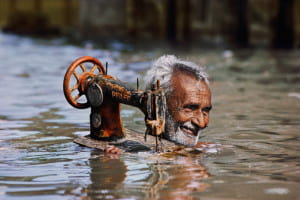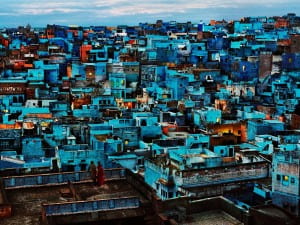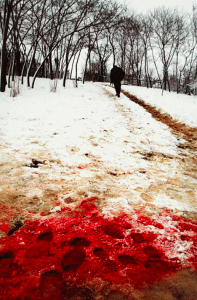I’ll be perfectly honest: I have never attended a photography show before, so I did not know what to expect when I arrived at the Rubin Museum. I suppose I was initially struck with how few photos there were; once I walked through the exhibit, I wanted to see so much more of his work. The photos that were there, though, were incredibly engaging. They were grand not only in scale, but also in the sheer amount of content they contained – most of the pictures contained multiple people or scenes and there was just so much to process as I stood before them. This never made the images feel busy, though; rather, they were awe-inspiringly full of life.
Overall, the best word I can use to describe the show as a whole is vibrant. All of the photos were overwhelmingly colorful. There were bursting pops of color everywhere, whether it was a girl’s clothing, powder from a Holi festival, a painted wall, or a man’s bright beard. The color was intense, and it led me to wonder how much McCurry had enhanced his photos. Never in my life have I seen such bold colors simply existing in nature – does this mean McCurry heightened the intensity of his colors, or should I take this fact as proof that his photography captures something extremely foreign to my personal life experience? I think it may be a little of both.
The colors were not the only factor contributing to the vibrancy of McCurry’s work. The images had an explicitly happy, positive, and hopeful tone. The bright colors aided in conveying this tone, but additionally, a lot of the subjects were smiling, dancing, bounding, or plainly looking content and peaceful. McCurry was not showing hardship. He was not photographing pain or struggle. This could not be more evident than in this photograph, showing an old man with a destroyed sewing machine making his way out of a flood from a monsoon. His sewing machine, perhaps his most significant possession, is completely ruined, and he is up to his neck in water, yet he has an enormous grin on his face. The man looks utterly blissful in spite of his present situation.
This image reminded me of one of Haviv’s shots from Blood and Honey which I can only describe as its photographic opposite. They are similar on the surface, but are polar opposites in terms of the mood they covey. Both photos depict an elderly person traveling away from something – the man, probably heading to dry land, and the woman, possibly leaving her home to find a safe refuge. The two people actually look fairly similar – gray hair and worn, wrinkled faces shape their persona. Their lives are seemingly being ruined in the moment the respective photographs were taken – the man is desperately clinging to his broken sewing machine, probably the source of his income, and the woman’s city is overrun with soldiers and war.
As similar as these two photographs physically look, the underlying aura of each is drastically different. The man and his sewing machine look hopeful and truly cheerful – but the woman in Bosnia is devastating to look at. These two opposing moods are representative of the greater works in which they are contained. Blood and Honey is not a positive work; it shows pain, war, and human desolation. Haviv’s photo of the old woman is entirely emblematic of the horror of the story he is trying to tell. McCurry’s photography of India is light and fairly cheery, and the sewing machine man embodies that spirit fully.
In addition to the positivity and vibrance of McCurry’s collection, there is another quality to his work that is more difficult to describe – the photos feel very majestic and nearly other-worldly. To put that in extreme terms, the bright colors and fanciful spirit of the images make them seem like they exist as paintings of a fantasy world. This is evidenced in a large way in McCurry’s image entitled “Blue City.”
This photograph captures the city of Jodhpur, India in all of its bright glory. The buildings, sky, and truly everything about this image are as blue as imaginable. When I first came to this image in the museum, I genuinely stopped and looked at it from every angle possible because I was convinced it was a painting. After research, I learned that this magical blue city certainly does exist – but there are other small details that really struck me that make this photograph so unbelievable. The microscopic yet clear detail is so impressive – I was struck by two separate people standing in their doorways, looking as though they were placed there with the stroke of a paintbrush.
At first glance, bold color is the only thing the viewer sees when looking at this one of McCurry’s photos. This reminded me of a boldly colored photograph of Haviv’s, his near-perfectly composed shot of blood in snow:
Like McCurry’s blue city photo, initially the only visible feature of this image is the deep, dark red pool of blood. It is shocking and striking. However, upon deep investigation of the image, small details like the people in the doorways of McCurry’s photo are evident. Within the pool of blood, there appear to be at least two distinct sets of footprints. There is a white piece of paper with (as far as I can tell) a black number three printed on it. How many people were involved in producing this red snow? What other clues did they leave behind? The small, mysterious details in both McCurry’s and Haviv’s photo are incredibly enticing – they leave me in awe and with many, many questions.
Steve McCurry’s photographs of India are unbelievably vibrant and truly magical. They provide a remarkably bright look into alluring aspects of Indian culture, and the photos are a reflection of McCurry’s love for the very culture he captured. Although the underlying tone is drastically more cheery, his photos are easily comparable, at least aesthetically, to some of Haviv darkest work. This is a testament to the incredibly striking quality of the photos – regardless of whether the tone is positive or negative, it is conveyed powerfully and beautifully.






Leave a Reply
You must be logged in to post a comment.